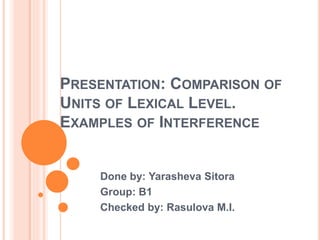
Presentation on typology.pptx
- 1. PRESENTATION: COMPARISON OF UNITS OF LEXICAL LEVEL. EXAMPLES OF INTERFERENCE Done by: Yarasheva Sitora Group: B1 Checked by: Rasulova M.I.
- 2. Language transfer (also known as L1 interference, linguistic interference, and cross meaning) refers to speakers or writers applying knowledge from their native language to a second language. Dulay et al (1982) define interference as the automatic transfer, due to habit, of the surface structure of the first language onto the surface of the target language. Lott (1983: 256) defines interference as ‘errors in the learner’s use of the foreign language that can be traced back to the mother tongue’. Ellis (1997: 51) refers to interference as ‘transfer’, which he says is ‘the influence that the learner’s L1 exerts over the acquisition of an L2′. He argues that transfer is governed by learners’ perceptions about what is transferable and by their stage of development in L2 learning. In learning a target language, learners construct their own interim rules (Selinker, 1971, Seligar, 1988 and Ellis, 1997) with the use of their L1 knowledge, but only when they believe it will help them in the learning task or when they have become sufficiently proficient in the L2 for transfer to be possible.
- 3. When an individual’s understanding of one language has an impact on his or her understanding of another language, that individual is experiencing language transfer. There can be negative transfers, otherwise known as interference, when the understanding of one language complicates the understanding of another language. Alternatively, there can be positive transfers such that knowing one language can aid in developing skills for a second language. Language interference is the effect of language learners’ first language on their production of the language they are learning. It means that the speaker’s first language influences his/her second or and his/her foreign language.
- 4. Corder suggests that the learner’s L1 may facilitate the development process of learning an L2, by helping him to progress more rapidly along the universal route when the L1 is similar to the L2. Krashen when he suggests that the learners can use the L1 to initiate utterances when they do not have sufficient acquired knowledge of the target language for this purpose. The relationship between the two languages must then be considered. Albert and Obler (1978) claim that people show more lexical interference on similar items. So it may follow that languages with more similar structures (e.g. English and French) are more susceptible to mutual interference than languages with fewer similar features (e.g. English and Japanese). On the other hand, we might also expect more learning difficulties, and thus more likelihood of performance interference at those points in L2 which are more distant from L1, as the learner would find it difficult to learn and understand a completely new and different usage. Hence the learner would resort to L1 structures for help.
- 5. FACTORS THAT CAUSE LANGUAGE INTERFERENCE Interference is a general problem that occurs in bilingualism. There are many factors that contribute interference (Weinrich, 1970:64-65): Firstly, speaker bilingualism background. Bilingualism is the major factor of interference as the speaker is influenced by both of the source and the target language. Secondly, the limited vocabularies of TL mastered by a learner. Vocabularies of certain language mostly are about words of surroundings connected to life. Thus, a learner who is willing to master another language will meet new words differ from his native words. In order to be able to speak as natives of TL, vocabularies take a big role. The more vocabularies someone has, the better he masters TL. Foreign language learner will try to put deliberately his native word to state some points when he cannot find the best words of TL.
- 6. FACTORS THAT CAUSE LANGUAGE INTERFERENCE Fourth, needs of synonym. Synonym in language usage plays an important role as word chosen variation in order not to repeat similar word during the communication process (redundancy). Implementing synonym in a language contact will contribute to interference in the form of adoption and borrowing of new words from SL to TL. Fifth, prestige and style. Applying unfamiliar words (foreign words) during a communication practice which dominant words are languages of both speaker and receiver is something else. Those unfamiliar words usage is aimed to get a pride. Interference will appear as there are certain words even though the receiver probably cannot catch the real idea of the speech. The usual unfamiliar words usage will become a style of the user.
- 7. Usually, a learner has been wrong in using a vocabulary caused by the similarity of the element between first language and second language, e.g. the use of cognate words (the same form of word in two languages with different functions or meanings). The example is the using of month and moon. Interference at a lexical level provides for the borrowing of words from one language and converting them to sound more natural in another and orthographic interference includes the spelling of one language altering another. Language interference influences in learning language target. It has positive and negative effects. The greater the differences between the two languages, the more negative the effects of interference are likely to be. It is important for teacher to know the differences and similarities between learner’s native language and the target language. By knowing them teacher will be easier to decide what strategy, methodology or what material that will be used in teaching second or foreign language.